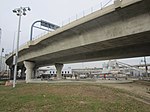North Bank Bridge
2012 establishments in MassachusettsBridges completed in 2012Bridges in MassachusettsBuildings and structures in Cambridge, MassachusettsMassachusetts building and structure stubs ... and 3 more
Massachusetts transportation stubsNortheastern United States bridge (structure) stubsPedestrian bridges in Massachusetts

The North Bank Bridge (sometimes North Bank Pedestrian Bridge) is a pedestrian and bicycle path bridge in Cambridge, Massachusetts. It connects the Cambridge portion of North Point Park with Paul Revere Park in nearby Charlestown on the northern side of the Charles River.
Excerpt from the Wikipedia article North Bank Bridge (License: CC BY-SA 3.0, Authors, Images).North Bank Bridge
North Bank Bridge, Cambridge
Geographical coordinates (GPS) Address Nearby Places Show on map
Geographical coordinates (GPS)
| Latitude | Longitude |
|---|---|
| N 42.3696 ° | E -71.0657 ° |
Address
Boston & Maine Railroad Signal Tower A
North Bank Bridge
02114 Cambridge
Massachusetts, United States
Open on Google Maps










